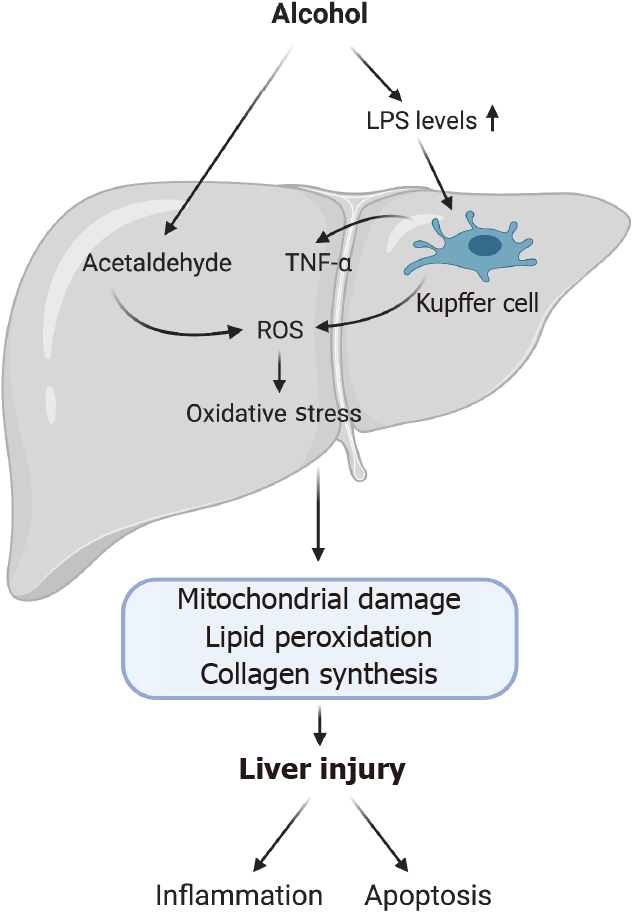Copyright
©The Author(s) 2021.
World J Biol Chem. Sep 27, 2021; 12(5): 87-103
Published online Sep 27, 2021. doi: 10.4331/wjbc.v12.i5.87
Published online Sep 27, 2021. doi: 10.4331/wjbc.v12.i5.87
Figure 1 Alcohol-related induction of oxidative stress and liver injury.
Alcohol misuse leads to loss of tight junctions in the gut increasing its permeability. This causes translocation of lipopolysaccharide into the liver activating toll-like receptor 4 on Kupffer cells (KCs). Activation of KCs can cause reactive oxygen species (ROS) production and pro-inflammatory cytokines such as tumor necrosis factor-α. ROS production also occurs due to the metabolism of alcohol. ROS production and inflammatory cytokines leads to inflammation and recruitment of inflammatory cells as well as activation of apoptotic pathways. (Figure created with BioRender.com). LPS: Lipopolysaccharide; ROS: Reactive oxygen species; TNF-α: Tumor necrosis factor-α.
Figure 2 The inflammatory response during alcoholic liver disease.
Excessive consumption of alcohol causes lipopolysaccharide release from the gut activating toll-like receptor 4 on Kupffer cells (KCs). Pattern recognition receptors become activated by pathogen-associated molecular patterns/damage-associated molecular patterns which induces inflammation via release of proinflammatory cytokines and inflammasome activation. Interleukin (IL)-18 production from KCs causes activation of natural killer cells. Toll-like receptor stimulation in hepatic stellate cells results in the expression of IL-6, transforming growth factor-β1 and tumor necrosis factor-α. (Figure created with BioRender.com). DAMPs: Damage-associated molecular patterns; FFA: Free fatty acids; PAMPs: Pathogen-associated molecular patterns; IL: Interleukin; LPS: Lipopolysaccharide; NF-κB: Nuclear factor-κB; NK: Natural killer; NLRP3: NOD-, LRR- and pyrin domain-containing protein 3; PRR: Pattern recognition receptor; ROS: Reactive oxygen species; TGF-β: Transforming growth factor β; TLR4: Toll-like receptor 4; TNF-α: Tumor necrosis factor-α.
Figure 3 Innate and adaptive immune response to alcohol exposure.
Kupffer cells, hepatic stellate cells and natural killer cells are components of the innate immune system which becomes activated following chronic alcohol consumption. This leads to the release of inflammatory cytokines, causing further recruitment of inflammatory cells. The adaptive immune system also becomes activated releasing inflammatory mediators as well as antibody generation to protein and Malondialdehyde-acetaldehyde adducts. Both immune response mechanisms eventually become dysregulated over time with alcohol consumption. (Figure created with BioRender.com). HSC: Hepatic stellate cell; IFN-γ: Interferon-γ; IL: Interleukin; KC: Kupffer cell; LPS: Lipopolysaccharide; NK: Natural killer; NKT: Natural killer T; ROS: Reactive oxygen species; TGF-β: Transforming growth factor β; TLR4: Toll-like receptor 4; TNF-α: Tumor necrosis factor-α.
- Citation: Petagine L, Zariwala MG, Patel VB. Alcoholic liver disease: Current insights into cellular mechanisms. World J Biol Chem 2021; 12(5): 87-103
- URL: https://www.wjgnet.com/1949-8454/full/v12/i5/87.htm
- DOI: https://dx.doi.org/10.4331/wjbc.v12.i5.87











